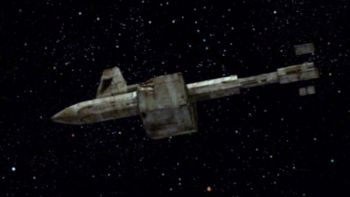DY-100 class
From Trekipedia
FASA Timeline
The DY-100, introduced in 1995, was the first mass-produced spacecraft capable of routine circumlunar (Earth-moon) travel. Interchangeable modules permitted wide diversity of mission profiles, including an upgrade for interplanetary travel that allowed it to take humans to Mars. The class remained in service until 2020.[1]
DY-100 class Vessels
Specifications
| Length | 100m |
| Beam | 23.37m |
| Draught | 34.9m |
| Mass | 2.72 million kg |
| Living Units/ Fuel Units/ Cargo Units | Interchangeable modules each 27x5.5x6.57m (795m³ usable volume) |
| Engine Section | Combination Chemical/Fission |
| Command Con | 12.3x7.4x4.9m |
| Complement |
|
| Navigation | Optical Tracker-Controlled Inertial Guidance |
| Communications | Laser Radiotelemetry |
| Computer | Standard Program-Dependent Digital Memory |
| Life Support |
|
Performance
| Range (Standard) | 900,000km |
| Range (Maximum) | 387 million km (refitted for duration travel) |
| Velocity (Cruising) | 55,000km/hour |
| Velocity (Maximum) | 80,000km/hour |
| Escape Velocity (Earth) | 38,000km/hour |
| Typical Voyage Duration | 9.2 hours (Earth-Moon) |
| Maximum Voyage (With Supply Stops) | 934 days (Earth-Mars-Asteropolis-Mars-Earth) |
| Thrust (Chemical) | 4.2 million kg
|
| Thrust (Fission) | 68,000 kg (average)
|
References
- ↑ Goldstein, Stan and Goldstein, Fred with Sternbach, Rick. Star Trek: Spaceflight Chronology. Pocket Books, 1980.
